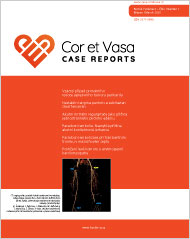 Cor et Vasa Case Reports
Cor et Vasa Case Reports
Svazek | Volume 3 • Číslo | Number 1
Březen | March 2020
 Cor et Vasa Case Reports
Cor et Vasa Case Reports
Svazek | Volume 3 • Číslo | Number 1
Březen | March 2020

M. Košťál, T. Zatočil, O. Savka, T. Ostřížek, P. Kala, O. Toman
Primární tumory perikardu jsou extrémně vzácná onemocnění se špatnou prognózou. Zpočátku jsou klinicky němé, jejich růst a diseminace do okolí vede k rozvoji často nespecifických obtíží. Prezentovaná kazuistika popisuje případ pacienta s vysoce nediferencovaným maligním sarkomatoidním tumorem perikardu, poukazuje na obtížnou diagnostiku tumorů perikardu a zdůrazňuje nutné rychlé zahájení jejich cílené terapie. Onemocnění se u daného pacienta v úvodu projevuje progredující dušností s bolestmi na hrudi. Při standardních vyšetřeních je zjištěna nově fibrilace síní s rychlou odpovědí komor, dále perikardiální výpotek, který progreduje a dospěl až k nutnosti perikardiocentézy. Opakovanými vyšetřeními s využitím řady zobrazovacích metod je vyjádřeno podezření na maligní onemocnění perikardu. Následně je provedena histologická verifikace z minitorakotomie, která podezření potvrzuje. Stav pacienta rychle progreduje a ještě před možným zahájením léčby dochází k jeho úmrtí.

A. Kažimírová, M. Hudec, M. Kamarád, R. Miklík
Angina pectoris je jednou z forem ischemické choroby srdeční s prevalencí 20 000–40 000 na jeden milion obyvatel. Příčinou jejího vzniku je nepoměr mezi dodávkou a spotřebou kyslíku myokardu, přičemž nejčastější příčinou je ateroskleróza koronárních tepen.1 Rozvoj kardiochirurgických výkonů s narůstajícím počtem pacientů s našitím aortokoronárního bypassu a využitím arteria mammaria interna však vede i ke zvyšujícímu se počtu klinické manifestace málo časté příčiny anginy pectoris, a to koronárního-subklaviálního steal syndromu. Prezentujeme kazuistiku pacientky s chronickou ischemickou chorobou srdeční, u které se po šestnácti letech od našití tepenného bypassu tento syndrom rozvinul a následně byl na našem pracovišti úspěšně řešen komplexní perkutánní revaskularizací.

E. Polaková, M. Horn, J. Veselka
Jednostranný plicní edém představuje asi 2 % kardiálních plicních edémů. Etiologie může být velmi různorodá, nicméně nejčastěji se jedná o těžkou mitrální regurgitaci. U většiny pacientů se vyskytuje v pravém horním plicním laloku. Vzhledem k atypické prezentaci bývá zahájení náležité léčby opožděno. Popisujeme případ pacienta s velmi dramatickou a netypickou mechanickou komplikací malého infarktu myokardu, jehož stav byl vstupně chybně hodnocen jako pneumonie. Pacient byl přijat pro rozvoj těžké respirační insuficience, byla zajištěna umělá plicní ventilace a stav vyžadoval zavedení venovenózní extrakorporální membránové oxygenace (VV ECMO). Až následně byla echokardiograficky zjištěna akutní těžká mitrální regurgitace při vlajícím zadním cípu s excentrickým proudem směřujícím k pravostranným plicním žilám. Selektivní koronarografií byla verifikována kritická stenóza ramus circumflexus před odstupem druhého ramus marginalis sinister a byla provedena prostá balonková angioplastika. S odstupem tří dnů byla provedena chirurgická náhrada mitrální chlopně. Cílem článku je popis neobvyklého případu a jeho patofyziologie.

L. Šujaková, J. Pařenica, J. Hlásenský, M. Keřkovský, T. Andrašina, Z. Šilhart, P. Kala
Akutní končetinová ischemie na podkladě paradoxní embolie je považována za vzácnou příhodu, ke které dochází při embolizaci žilního trombu do tepenného řečiště při pravolevém srdečním zkratu (perzistující foramen ovale / defekt septa síní). V představené kazuistice demonstrujeme případ 28leté ženy hospitalizované pro dušnost a bolesti obou dolních končetin s následným průkazem masivní plicní embolizace a mnohočetných okluzí v tepenném řečišti obou dolních končetin. V našem případě byla pacientka úspěšně léčena podáním systémové trombolýzy s následnou chirurgickou trombembolektomií, která vedla ke kompletní obnově perfuze postižených končetin. Dále je diskutován výběr léčebné strategie ve srovnání s dalšími dostupnými možnostmi terapeutických intervencí akutní končetinové ischemie a prevence recidivy embolizační příhody.

M. Ráchela, A. Staňková, J. Málek, J. Matějka, J. Večeřa
Paradoxní embolizace je klinickou formou tromboembolismu, kdy trombus formovaný v žilním systému přechází přes intrakardiální nebo plicní zkrat do systémové cirkulace. Nejčastěji je asociována s patentním foramen ovale (PFO), přičemž záchyt trombu v něm je vzácný. Prezentujeme případ 87leté pacientky s akutní plicní embolií, tranzientním trombem v mezisíňovém septu a multiorgánovou paradoxní embolizací. V akutní fázi léčby trombu v PFO je preferována chirurgická trombembolektomie, ale dle hemodynamického stavu, přidružených onemocnění a chirurgického rizika je akceptovatelná také antikoagulační a trombolytická léčba. Vzhledem ke koincidenci akutního infarktu myokardu, ischemické cévní mozkové příhody a plicní embolie byla nemocná léčena trombolýzou. V sekundární prevenci byla u ní indikována trvalá antikoagulační léčba.

J. Hrečko, M. Solař, K. Mědílek, P. Solařová, M. Hujňáková
Souhrn Arytmogenní kardiomyopatie (AKMP) je geneticky podmíněné onemocnění srdečního svalu spojené s vyšším rizikem maligních arytmií. Kazuistika popisuje případ mladé ženy s komorovou tachykardií, u které byla diagnostikována AKMP s významným postižením levé komory. Cílem sdělení je shrnout současné možnosti diagnostiky AKMP a ukázat specifické črty postižení levé komory u AKMP.